Dental Pulp Capping
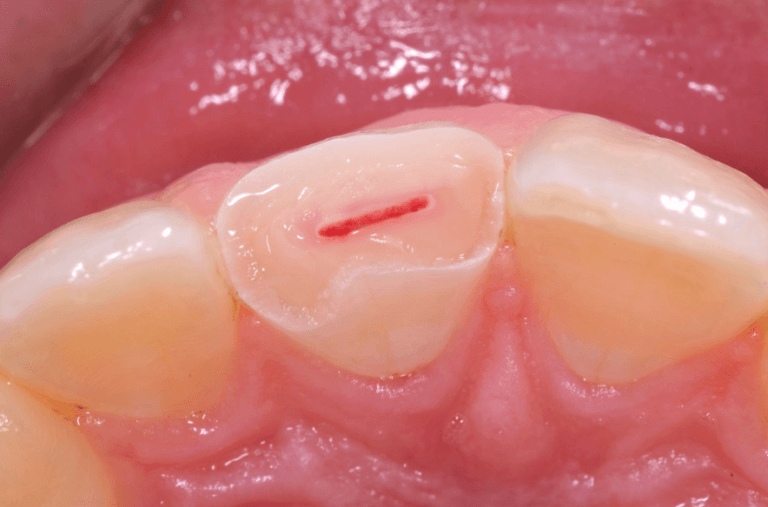
What Is Dental Pulp Capping?
When it comes to maintaining a healthy and vibrant smile, understanding the various aspects of dental care is essential. One crucial procedure that plays a significant role in preserving the integrity of your teeth is dental pulp capping. This dental treatment may sound complex, but fear not; we’re here to break it down in simple terms.
The dental pulp is the soft innermost tissue located within a tooth. It consists of sensitive nerve fibers, blood vessels, and connective tissues. The dental pulp plays a vital role in maintaining the health of the tooth by nourishing it, transmitting sensory information (such as temperature and pain sensations), and helping with tooth development. When the dental pulp becomes infected or damaged due to factors like decay or trauma, it may require treatment such as dental pulp capping, or removal through procedures like root canal treatment to preserve the tooth’s function and structure.
Dental pulp capping is a dental procedure aimed at saving the dental pulp inside the tooth that has been affected by tooth decay or tooth trauma. If left untreated, the dental pulp can die and become necrotic, leading to potential tooth pain and infection. Before deciding on whether Dental Pulp Capping are right for you, there are some things you should know:
- Who Needs Dental Pulp Capping?
- What Are The Advantages Of Dental Pulp Capping?
- What Are The Different Types Of Dental Pulp Capping?
- What Are The Indications For Dental Pulp Capping?
- What Are The Contraindications For Dental Pulp Capping?
- What Are The Alternative Treatments If I Do Not Choose Dental Pulp Capping?
- How Much Does Dental Pulp Capping Cost?
- What Are The Steps In The Dental Pulp Capping Procedure?
- Can I Have Dental Pulp Capping If I Am Pregnant?
- What Are Common Problems With Dental Pulp Capping?
If you have any further questions about Dental Pulp Capping or other dental services offered at Atlas Dental, please contact us.

Free phone consultation
Have questions about Dental Pulp Capping? Schedule a free phone consultation with our Toronto dentist.

5 star google reviews
Our patients love us! See for yourself why more and more people are choosing Atlas Dental for Dental Pulp Capping.

Book Emergency tooth filling
Do you think you have cavities and need a Dental Pulp Cap? Book an emergency tooth filling online.
Who Needs Dental Pulp Capping?
Dental pulp capping is a valuable procedure that comes into play when certain dental issues arise. But who exactly might need dental pulp capping, and what are the common scenarios that lead to this treatment? Let’s explore some situations where this procedure becomes necessary:
- Deep Cavities: Deep cavities or large fillings that are close to the dental pulp can pose a risk to the tooth’s health. In such cases, dental pulp capping can serve as a protective measure to shield the pulp from additional damage and promote healing.
- Injury or Trauma: Dental injuries, such as a chipped or cracked tooth, can expose the dental pulp to external contaminants and bacteria. Dental pulp capping may be performed to safeguard the pulp and promote tissue repair, ultimately preserving the tooth.
- Multiple Dental Restorations: In some cases, teeth that have undergone multiple dental restorative procedures, such as numerous fillings on the same tooth, may become susceptible to pulp-related issues. Dental pulp capping can be considered as an option to prevent further invasive treatments.
- Abscess Prevention: Dental abscesses are painful infections that can occur when bacteria reach the dental pulp. Dental pulp capping can help prevent the development of abscesses by addressing the issue early and maintaining the tooth’s structural integrity.
It’s important to note that not every case of dental decay or damage will require dental pulp capping. Your dentist will carefully evaluate your specific condition and recommend the most suitable treatment option. In some instances, a root canal procedure may be necessary if the dental pulp is too severely damaged. However, dental pulp capping remains an effective method for preserving tooth function and aesthetics in less severe cases. If you have further questions about Dental Pulp Capping, please contact us.
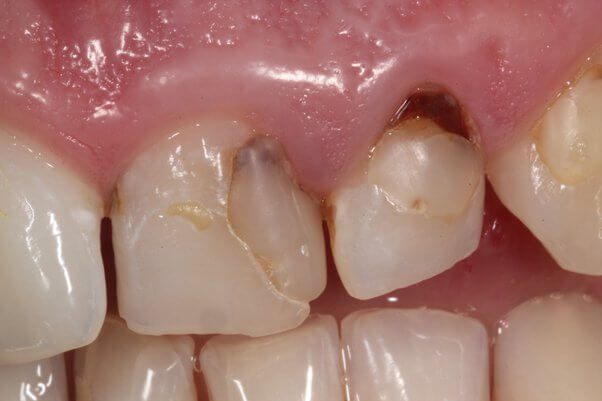
What Are The Advantages Of Dental Pulp Capping?
Dental pulp capping may not be as widely discussed as other dental procedures, but it offers several significant advantages for both your oral health and overall well-being. Understanding these benefits can help you appreciate why dental pulp capping is a valuable option in certain situations. Here are the advantages of dental pulp capping:
- Preservation of Natural Teeth: One of the most significant advantages of dental pulp capping is that it allows you to keep your natural tooth. Unlike some procedures that involve tooth extraction or root canal therapy, pulp capping aims to maintain the integrity of your original tooth structure.
- Minimal Invasiveness: Dental pulp capping is a minimally invasive procedure when compared to more extensive treatments like root canals. It involves removing only the decayed or damaged portions of the tooth, which means less discomfort and a quicker recovery.
- Promotes Natural Healing: Pulp capping encourages the dental pulp to heal itself. By applying protective materials over the exposed or affected pulp, the body’s natural regenerative processes are stimulated, helping to repair and strengthen the tooth from within.
- Preserves Tooth Function: By preserving the natural tooth, dental pulp capping maintains its functionality for biting, chewing, and speaking. This is crucial for your overall oral health and quality of life.
- Cost-Effective: Compared to more extensive dental treatments like root canals or tooth replacements, dental pulp capping is often a cost-effective solution. It can save you both time and money in the long run.
- Prevents Further Complications: Dental pulp capping is a preventive measure. By addressing dental issues in their early stages, it helps prevent more severe problems like dental abscesses or the need for tooth extraction.
It’s important to note that the success of dental pulp capping depends on various factors, including the extent of the pulp damage, timely intervention, and proper aftercare. While dental pulp capping is a valuable option, it may not be suitable for all cases. Your dentist will assess your specific condition and recommend the most appropriate treatment to address your dental needs effectively. If you have further questions about Dental Pulp Capping, please contact us.
What Are The Different Types Of Dental Pulp Capping?
Dental pulp capping is not a one-size-fits-all procedure; it comes in different forms, each tailored to specific dental situations. The two primary types of dental pulp capping are “direct pulp capping” and “indirect pulp capping:”
Direct Pulp Capping
Direct pulp capping is a procedure performed when the dental pulp has been partially exposed due to a minor injury or decay that has not reached the full depth of the pulp. This method aims to preserve the pulp’s vitality and stimulate its natural healing process. Direct pulp capping is generally recommended when the pulp exposure is minimal and the tooth’s overall health can be preserved. However, the success of this procedure largely depends on early intervention and proper sealing of the pulp.
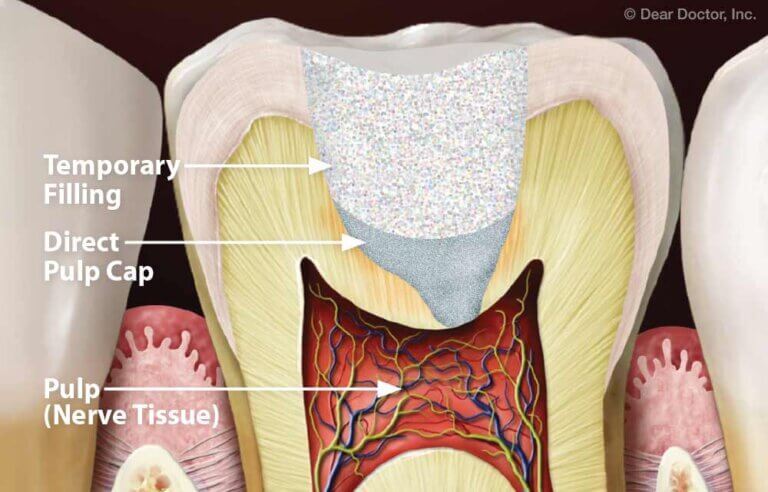
Indirect Pulp Capping
Indirect pulp capping is employed when the dental pulp is not directly exposed but has the potential to become irritated or infected due to deep cavities or extensive dental work. This technique is used to prevent future complications and maintain the health of the dental pulp. Indirect pulp capping is typically chosen when there’s a concern that direct pulp capping may not be feasible due to the extent of tooth decay. By preserving the pulp’s health before it becomes compromised, this approach helps avoid more invasive procedures like root canals.
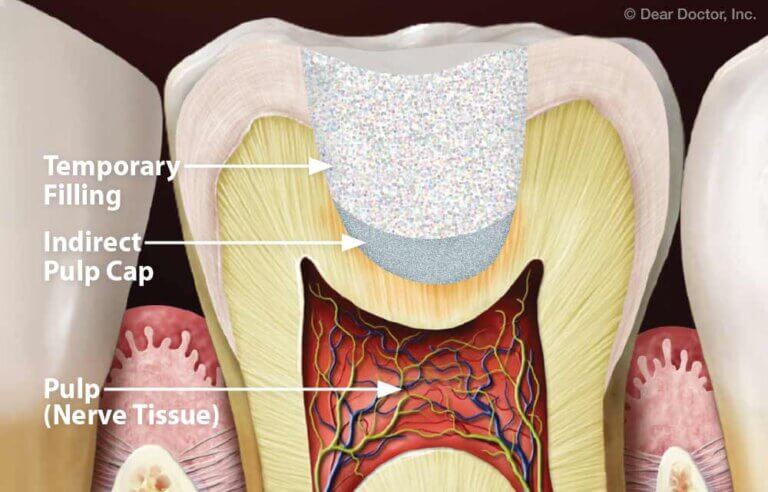
It’s important to note that the success of both direct and indirect pulp capping relies on early detection, appropriate treatment, and regular follow-up visits with your dentist. Your dentist will determine the most suitable approach based on your specific dental condition to ensure the best possible outcome for your tooth’s health and longevity. If you have further questions about Dental Pulp Capping, please contact us.
What Are The Indications For Dental Pulp Capping?
Dental pulp capping is a dental procedure that’s employed in specific situations where it can be beneficial for preserving a tooth’s health. Dentists consider various factors when determining if dental pulp capping is the right course of action. Here are the common indications or situations that may warrant dental pulp capping:
- Deep Cavities: When deep cavities or caries approach the pulp but haven’t yet fully invaded it, dental pulp capping can help prevent further damage and infection. It’s often considered when the decay is close to but hasn’t reached the pulp chamber.
- Minimal Pulp Exposure: Dental pulp capping is typically recommended when the dental pulp is minimally exposed due to decay, trauma, or dental work. If the pulp is only partially exposed and the surrounding tooth structure is healthy, pulp capping may be a suitable option.
- Absence of Severe Tooth Pain Symptoms: If a tooth with pulp exposure doesn’t exhibit symptoms of infection or inflammation, such as severe pain or swelling, it may be a candidate for dental pulp capping. Early intervention before symptoms develop can yield better results.
- Vital Pulp: For dental pulp capping to be successful, the pulp must still be vital, meaning it should have the potential to heal and regenerate. This is typically assessed through dental examinations and X-rays.
- Good Overall Tooth Health: The tooth surrounding the exposed or affected pulp should be in good condition. Dental pulp capping is more likely to succeed if the tooth’s structure is sound and able to support the restoration.
- Patient’s Preferences: In cases where patients prefer to preserve their natural tooth rather than pursue more invasive treatments like root canals or extractions, dental pulp capping may be a suitable choice.
It’s crucial to note that not all cases of pulp exposure or tooth decay will meet these criteria. Dentists carefully evaluate each patient’s unique circumstances to determine the most appropriate treatment plan. In cases where dental pulp capping may not be the best option, alternative treatments such as root canal therapy or tooth extraction may be recommended. If you have further questions about Dental Pulp Capping, please contact us.
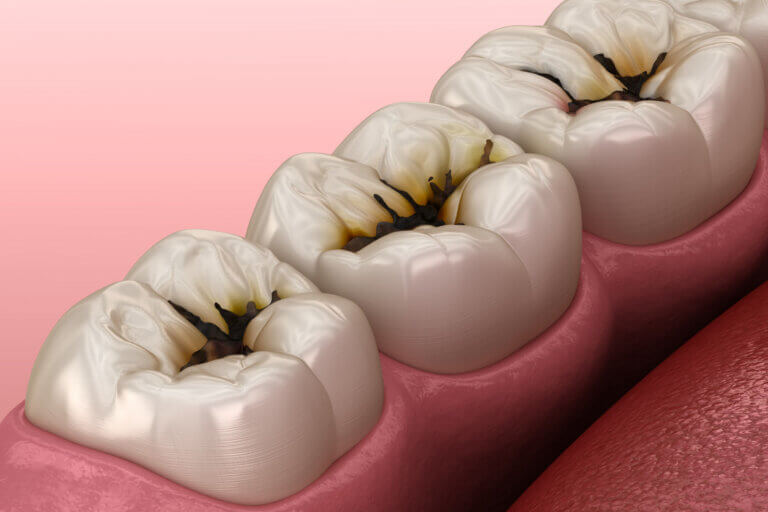
What Are The Contraindications For Dental Pulp Capping?
While dental pulp capping is a valuable procedure for preserving teeth in certain situations, it may not be suitable for everyone or every dental condition. Dentists carefully assess each case to determine if dental pulp capping is appropriate, taking into consideration specific contraindications that may suggest alternative treatments are needed. Here are some common scenarios where dental pulp capping would not be recommended:
- Extensive Pulp Damage: Dental pulp capping is typically not recommended when the pulp damage is extensive, such as in cases of deep infection, advanced decay, or when the pulp tissue is severely inflamed. In such situations, more invasive treatments like root canal therapy may be necessary.
- Pulp Necrosis: If the dental pulp is already necrotic (non-vital), meaning it is no longer capable of healing and regenerating, dental pulp capping is unlikely to succeed. In these cases, root canal treatment is often the preferred option.
- Fractured Tooth: Teeth that are severely fractured or have extensive structural damage may not be suitable candidates for dental pulp capping. The tooth’s structural integrity is crucial for the success of this procedure.
- Multiple Previous Dental Procedures: Teeth that have undergone multiple dental procedures, especially in the same area, may not respond well to dental pulp capping. The risk of complications or treatment failure can be higher in such cases.
- Poor Overall Tooth Health: Teeth with significant periodontal (gum) disease or other oral health issues may not be ideal candidates for dental pulp capping. A stable oral environment is essential for the success of the procedure.
- Active Dental Infections: If there is an active infection in the tooth or the surrounding tissues, dental pulp capping is generally contraindicated. Infections must be treated and resolved before considering pulp capping.
It’s essential to understand that dental pulp capping is not a one-size-fits-all solution, and its success depends on careful patient assessment and adherence to best practices. Dentists will conduct a thorough evaluation, including X-rays and clinical assessments, to determine the most suitable treatment plan for each individual case. If you have further questions about Dental Pulp Capping, please contact us.
What Are The Alternative Treatments If I Do Not Choose Dental Pulp Capping?
If you and your dentist decide that dental pulp capping is not the most appropriate treatment option for your dental condition, several alternative treatments may be considered based on the severity of the issue and the overall health of the affected tooth. Here are some common alternatives to dental pulp capping:
- Root Canal Therapy: Root canal therapy, also known as endodontic treatment, is a procedure used to treat teeth with infected or irreversibly damaged pulp. During a root canal, the infected or damaged pulp is removed, the root canal space is cleaned and disinfected, and the tooth is sealed with a filling or crown to restore its function. Root canals are often recommended when the dental pulp is no longer capable of healing itself.
- Tooth Extraction: In cases where the tooth is severely compromised, such as extensive decay, structural damage, or infection that cannot be effectively treated, tooth extraction may be the only viable option. Once the tooth is removed, your dentist can discuss replacement options, such as dental implants, bridges, or dentures, to restore your smile’s function and aesthetics.
- Partial Dentures or Dental Bridges: If a tooth is extracted, you have the option of replacing it with a dental bridge or a partial denture. These prosthetic devices are designed to fill the gap left by the missing tooth, restoring your ability to chew and speak properly.
- Dental Implants: Dental implants are a long-term solution for replacing missing teeth. They consist of a titanium post surgically placed in the jawbone, which acts as a sturdy foundation for a custom-made artificial tooth. Implants are a popular choice for their natural appearance and durability.
The choice of alternative treatment depends on various factors, including the tooth’s condition, your overall oral health, budget considerations, and your personal preferences. Your dentist will thoroughly evaluate your situation and discuss the pros and cons of each alternative treatment option, allowing you to make an informed decision that best suits your needs and goals for oral health and aesthetics. If you have further questions about Dental Pulp Capping, please contact us.
Cost of Dental Pulp Capping
The cost of Dental Pulp Capping, whether it is done using a direct or indirect technique, is the same as the cost of a dental filling.
Whether it is an amalgam filling, composite resin filling, or glass ionomer filling, the cost of any of these Dental Fillings are similar and will depend on the location of the tooth (anterior, bicuspid or molar), as well as the size of the filling, which is translated as the number of “surfaces” involved. Imagine each tooth as a 5 surface box. Each “surface” that gets incorporated will dictate the size (and overall cost) of the tooth filling. Therefore, the cost of a filling can range between $200-460. The codes relevant to dental fillings in the Ontario Dental Association’s Suggested Fee Guide appear as follows:
Permanent Anteriors:
- 23111 – One surface: $200
- 23112 – Two surfaces: $250
- 23113 – Three surfaces: $300
- 23114 – Four surfaces: $370
- 23115 – Five surfaces (maximum surfaces per tooth): $390
Permanent Bicuspids:
- 23311 – One surface: $220
- 23312 – Two surfaces: $275
- 23313 – Three surfaces: $330
- 23314 – Four surfaces: $400
- 23315 – Five surfaces or maximum surfaces per tooth: $420
Permanent Molars:
- 23321 – One surface: $240
- 23322 – Two surfaces: $300
- 23323 – Three surfaces: $360
- 23324 – Four surfaces: $440
- 23325 – Five surfaces or maximum surfaces per tooth: $460
Dental Fillings are considered a basic service under all dental insurance plans and should be covered to your maximum insurable limit, but be sure to find out from your dental insurance plan provider how much you are eligible for before going ahead with dental treatment. Our fees are consistent with the ODA Fee Guide.
For patients without dental insurance, Atlas Dental is pleased to offer dental financing through Dentalcard. Affordable payment plans start at 7.95% for terms of 6 months to 6 years. To learn more about Dentalcard dental treatment financing, follow this link.
What Are The Steps In The Dental Pulp Capping Procedure?
The dental pulp capping procedure is a carefully executed process designed to preserve the health of a tooth with minimal pulp exposure. Dentists follow a series of steps to ensure the success of this treatment. Here’s an overview of the typical steps involved in the dental pulp capping procedure:
- Dental Examination: The process begins with a thorough dental examination. Your dentist will evaluate the affected tooth’s condition, including the extent of decay or damage and the overall health of the dental pulp. X-rays may be taken to get a more detailed view of the tooth’s interior.
- Local Anesthesia: To ensure your comfort throughout the procedure, your dentist will administer a local anesthetic to numb the area around the affected tooth. This will prevent you from feeling any pain or discomfort during the treatment.
- Tooth Isolation: To maintain a sterile field and keep the tooth dry, your dentist will use a rubber dam to isolate the affected tooth. This small, flexible sheet is placed around the tooth and anchored with clips, ensuring saliva and moisture do not interfere with the procedure.
- Removal of Decay: If there is any decay or damaged tooth structure, your dentist will carefully remove it using specialized dental instruments. This step is essential to eliminate the source of the dental problem and create a clean environment for the pulp capping. Invariably, the pulp space inside the tooth may be exposed.
- Application of Protective Material: Once the decay is removed and the tooth is prepared, your dentist will apply a biocompatible material directly over the exposed pulp, such as a calcium hydroxide paste or mineral trioxide aggregate (MTA). This material is often a biocompatible substance designed to stimulate the pulp’s natural healing and provide a barrier against bacteria.
- Sealing the Tooth: After the protective material is placed, your dentist will seal the tooth using a restorative material, such as a dental filling or dental crown. The choice of material will depend on the extent of tooth structure removed and the tooth’s location in your mouth.
- Final Adjustments: Your dentist will make any necessary adjustments to ensure the tooth’s proper function and alignment with your other teeth. This may involve shaping the dental filling or crown to fit your bite comfortably.
- Post-Procedure Care: Your dentist will provide you with tooth filling post-procedure care instructions, which typically include guidelines on oral hygiene, dietary restrictions, and what to expect during the healing process. It’s crucial to follow these instructions to maximize the success of the procedure. Depending on your dentist’s recommendations and your tooth’s response to the procedure, you may need to schedule follow-up appointments to monitor the tooth’s health and make any necessary adjustments.
Understanding these steps can empower you to make informed decisions about your dental health. If you have further questions about Dental Pulp Capping, please contact us.
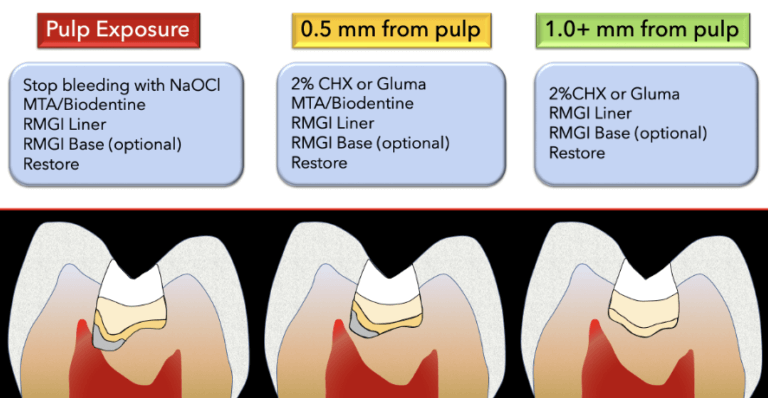
Can I Have Dental Pulp Capping If I Am Pregnant?
Pregnancy is a time when many women become particularly conscious of their health, including their dental health. If you are pregnant and experiencing dental issues that may require treatment like dental pulp capping, you may have concerns about its safety for both you and your baby. Here’s what you need to know:
- Consult Your Healthcare Team: The first step if you require dental treatment during pregnancy is to consult with your healthcare team, including your obstetrician and dentist. They can provide guidance specific to your situation and coordinate your care to ensure both your dental health and pregnancy are managed effectively.
- Timing Matters: Whenever possible, dental treatments, including dental pulp capping, are typically scheduled during the second trimester of pregnancy. This period is considered the safest for non-urgent dental procedures because the risk of complications is lower.
- Local Anesthesia: Local anesthesia used during dental procedures is generally considered safe during pregnancy. The amounts used in dentistry are minimal and unlikely to affect the developing fetus.
- Radiation Safety: Dental X-rays are usually avoided during pregnancy, especially during the first trimester, to minimize radiation exposure to the developing fetus. If X-rays are absolutely necessary, your dentist will take precautions, such as using a lead apron, to shield your abdominal area.
- Medications and Materials: Your dentist will select dental materials and medications that are considered safe during pregnancy. For dental pulp capping, materials like calcium hydroxide or mineral trioxide aggregate (MTA) are generally considered safe choices.
While dental pulp capping and other dental procedures are generally considered safe during pregnancy, it’s crucial to prioritize preventive dental care and maintain regular dental check-ups throughout your pregnancy. Good oral health can contribute to your overall well-being during this critical time. If you have further questions about Dental Pulp Capping, please contact us.
What Are Common Problems With Dental Pulp Capping?
While dental pulp capping is a valuable procedure for preserving teeth in certain situations, it is not without its potential challenges and issues. Despite careful execution and adherence to best practices, some common problems can arise following dental pulp capping. Here are some of the typical challenges associated with this procedure:
- Pulp Infection or Inflammation: One of the primary concerns with dental pulp capping is the potential for the pulp to become infected or inflamed despite protective measures. If bacteria penetrate the pulp chamber, it can lead to discomfort, pain, or even the need for a more invasive treatment like root canal therapy.
- Persistent Pain or Discomfort: While dental pulp capping is generally considered a minimally painful procedure, some patients may experience persistent pain or discomfort after the treatment. This discomfort may be due to various factors, such as an incomplete seal, post-procedure inflammation, or the extent of the pulp damage.
- Tooth Sensitivity: After dental pulp capping, some patients may experience heightened tooth sensitivity to temperature changes, hot or cold foods, or even pressure when biting or chewing. This sensitivity usually subsides as the tooth heals, but it can be uncomfortable in the short term.
It’s important to recognize that while these problems can occur, dental pulp capping remains a valuable treatment option when appropriate. To minimize the risk of common problems with dental pulp capping, it’s essential to maintain good oral hygiene practices, attend regular dental check-ups, and adhere to your dentist’s post-treatment care instructions. If you have further questions about Dental Pulp Capping, please contact us.
We also think you’ll like…
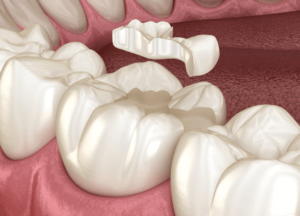
Porcelain Inlay Recementation
Porcelain Inlay Recementation What Is Dental Inlay Recementation? A Porcelain Inlay is a type of dental restoration crafted from high-quality, biocompatible porcelain material. These restorations
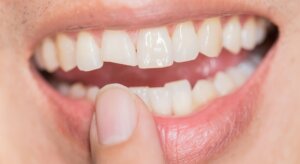
Broken Tooth
Broken Tooth What Is A Broken Tooth? A Broken Tooth refers to a tooth that has been cracked, fractured or chipped. It can be caused
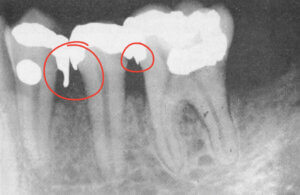
Dental Filling Overhanging Margin
Dental Filling Overhanging Margin What Is A Dental Filling Overhanging Margin? A Dental Filling is a restorative dental treatment used to repair a damaged or

Cracked Tooth
Cracked Tooth What Is A Cracked Tooth? A Cracked Tooth is a common dental problem that can happen to anyone at any age. It occurs
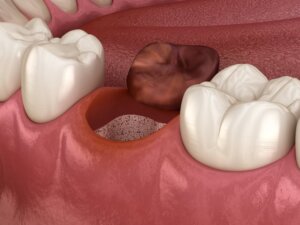
Dry Socket: Symptoms, Causes, Prevention & Treatment
Dry Socket: Symptoms, Causes, Prevention & Treatment What Is A Dry Socket? Dry socket is also called alveolar osteitis. After having regular tooth removal or
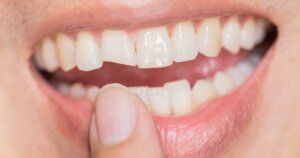
Cracked, Chipped or Broken Tooth
How To Fix My Cracked, Chipped or Broken Tooth Help! I Have A Broken Tooth And Don’t Know What To Do! If a piece of

